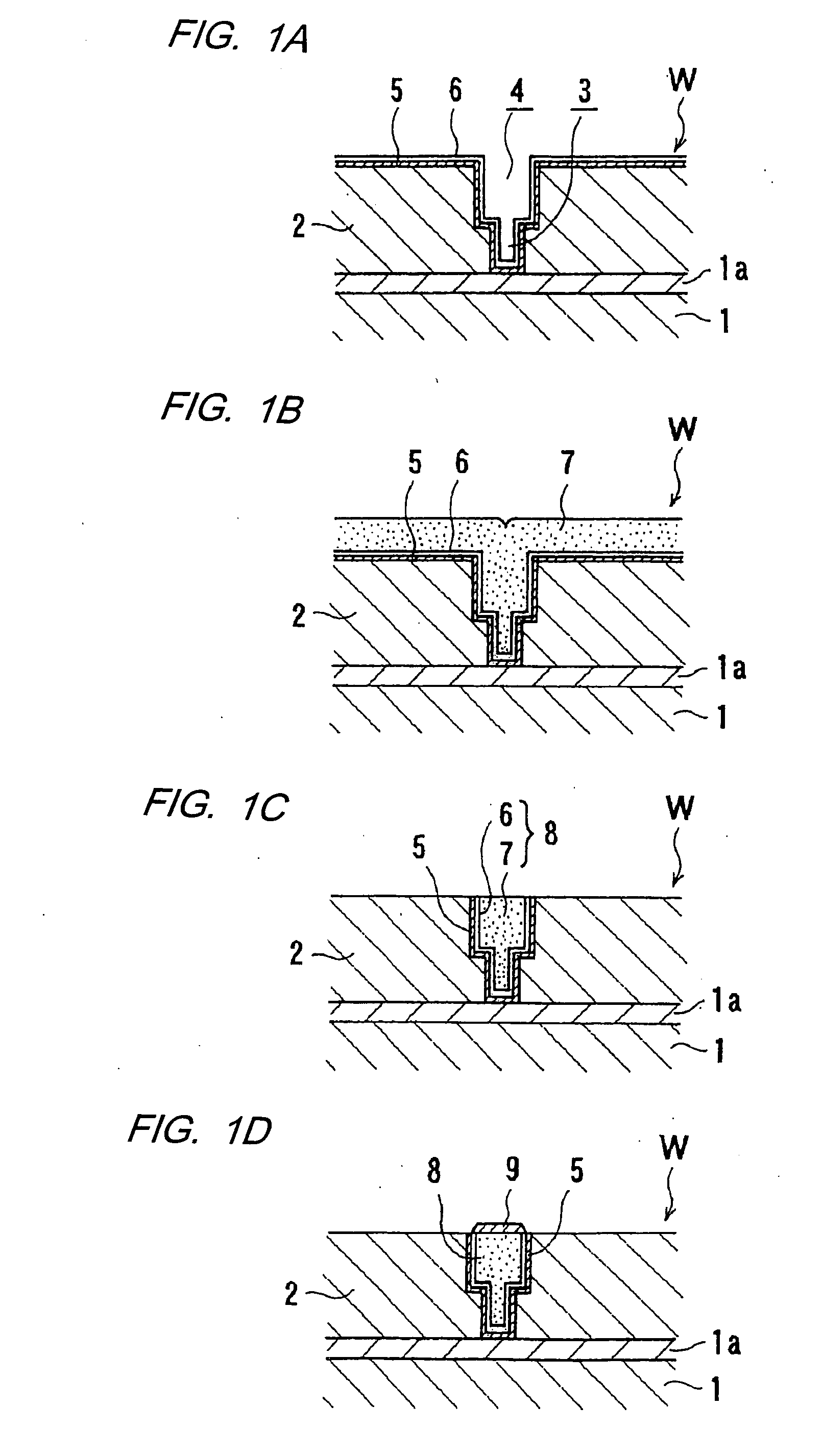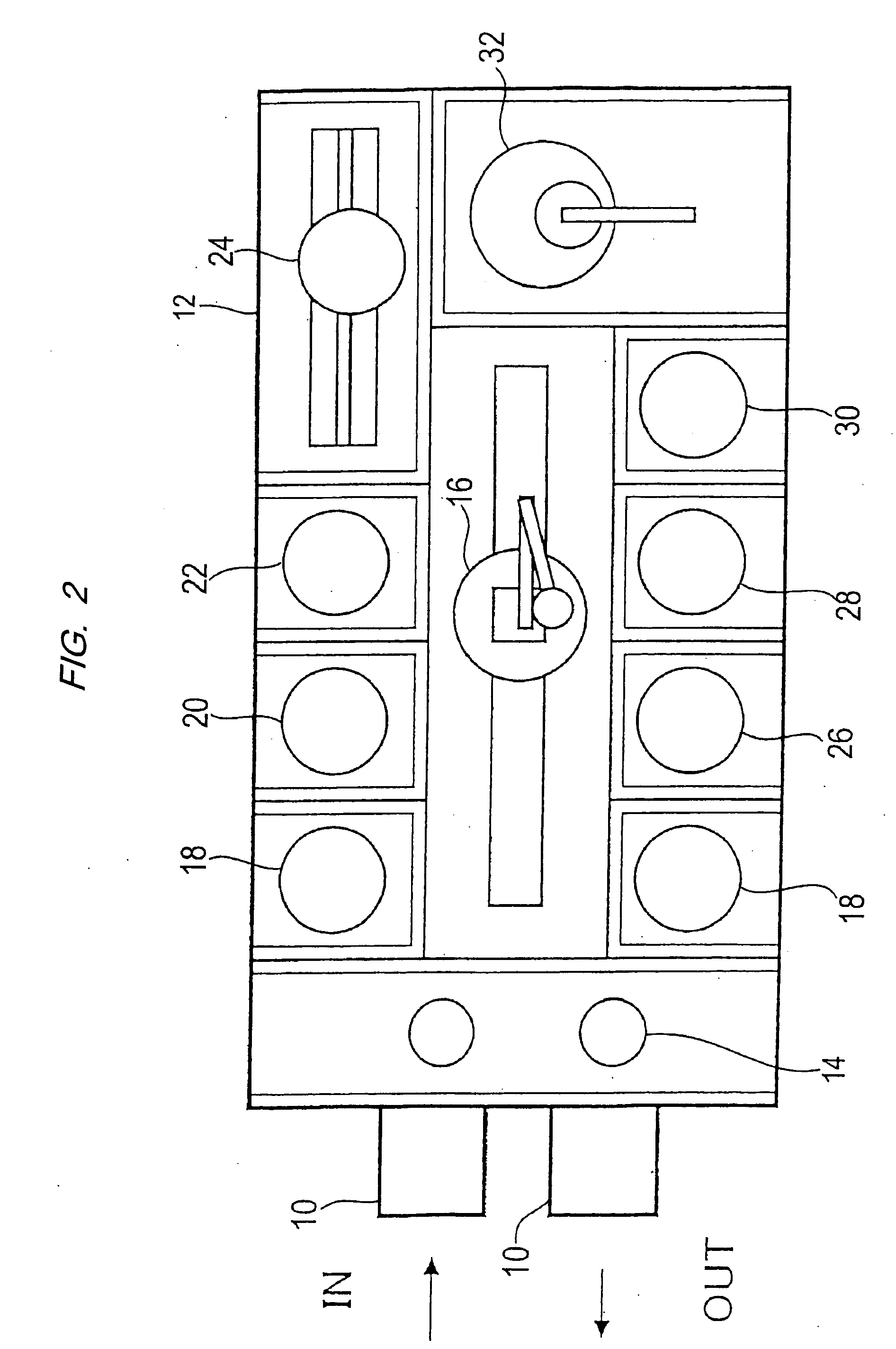Plating apparatus and plating method
a plating apparatus and plating technology, applied in the direction of electrolysis process, semiconductor devices, electrolysis components, etc., can solve the problems of increased raw material costs, increased raw material cost, and longer plating time required
- Summary
- Abstract
- Description
- Claims
- Application Information
AI Technical Summary
Benefits of technology
Problems solved by technology
Method used
Image
Examples
example 1
[0168] As shown in FIG. 28, a number of fine interconnect trenches 40 each having a width of 0.18 μm and a depth of 1.0 μm at close intervals of 0.18 μm, and a single wider interconnect trench 42 having a width of 20 μm and a depth of 1.0 μm are formed in a silicon wafer 44 having a diameter of 200 mm. After a barrier layer is deposited on the surface of the silicon wafer 44 by PVD, a copper seed layer as a conductive layer is deposited to a thickness of 80 nm on the barrier layer by PVD to prepare a sample.
[0169] Using a copper sulfate plating solution having the composition described below, the surface of the sample was subjected to electroplating by a plating apparatus which is essentially the same structure as the plating apparatus shown in FIG. 3 to deposit a copper plated film 46 having a thickness of about 500 nm on the surface of the copper seed layer. [0170] Copper sulfate 5-hydrate: 200 g / L [0171] Sulfuric acid: 50 g / L [0172] Chloride: 60 mg / L [0173] Sulfur compound (N,N-...
example 2
[0178] Using the same sample as with Example 1 and under the same plating conditions as with Example 1, the surface of the sample was subjected to electroplating to deposit a plated copper film 46 (see FIG. 28) having a thickness of about 500 nm on the surface of the copper seed layer. However, the plating solution used contained 150 mg / L of polyoxypropylenetriol (molecular weight=300), rather than polypropylene glycol used in Example 1, as the high polymer compound. The deposited plated copper film 46 was evaluated in terms of the flatness index and the surface step as with Example 1.
example 3
[0179] Using the same sample as with Example 1 and the plating solution having the same composition as with Example 1, the surface of the sample was subjected to electroplating to deposit a plated copper film 46 (see FIG. 28) having a thickness of about 500 nm on the surface of the copper seed layer. The plating conditions were as follows: The copper seed layer on the sample and the lower pad (porous member) 534a were brought into contact with each other, and the lower pad 534a was vibrated for 3 seconds. After the vibration of the lower pad 534a was stopped, an electric current at a current density of 10 mA / cm2 was passed between the copper seed layer on the sample and the anode 526 for 10 seconds. After the supply of the electric current between the copper seed layer on the sample and the anode 526 was stopped, the lower pad 534a was released from the copper seed layer on the sample, and the electrode head 502 was left to stand for 2 to 3 seconds. The above process beginning with ...
PUM
| Property | Measurement | Unit |
|---|---|---|
| concentration | aaaaa | aaaaa |
| concentration | aaaaa | aaaaa |
| concentration | aaaaa | aaaaa |
Abstract
Description
Claims
Application Information
 Login to View More
Login to View More - R&D
- Intellectual Property
- Life Sciences
- Materials
- Tech Scout
- Unparalleled Data Quality
- Higher Quality Content
- 60% Fewer Hallucinations
Browse by: Latest US Patents, China's latest patents, Technical Efficacy Thesaurus, Application Domain, Technology Topic, Popular Technical Reports.
© 2025 PatSnap. All rights reserved.Legal|Privacy policy|Modern Slavery Act Transparency Statement|Sitemap|About US| Contact US: help@patsnap.com



